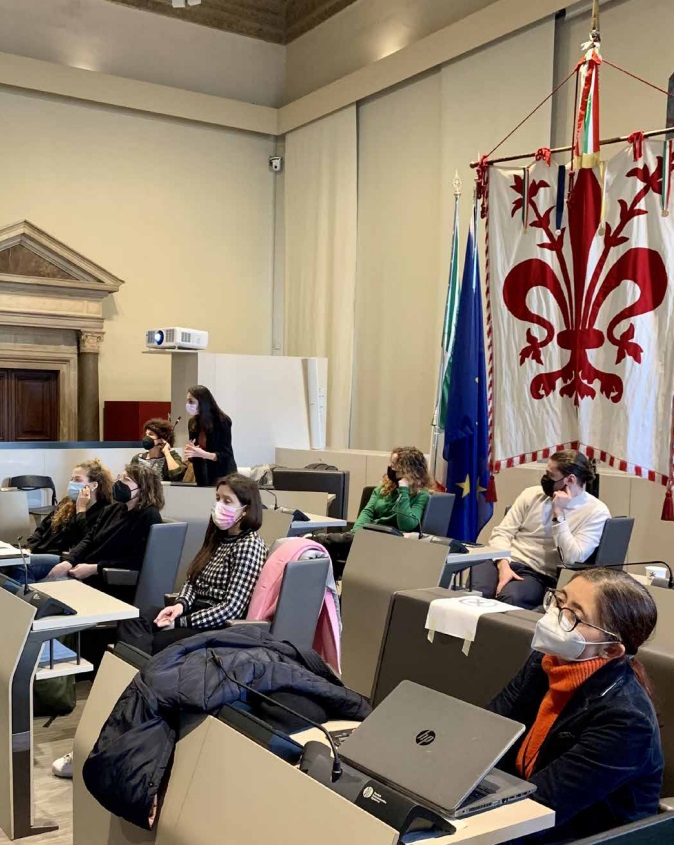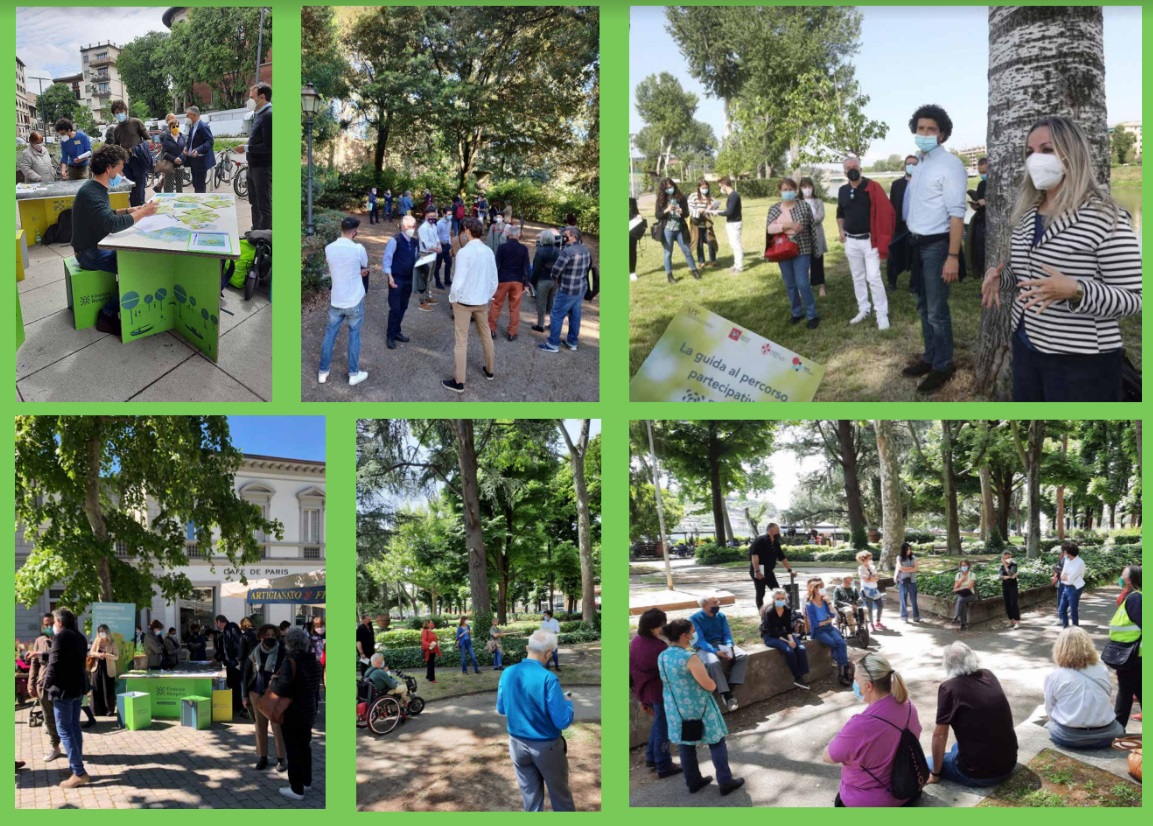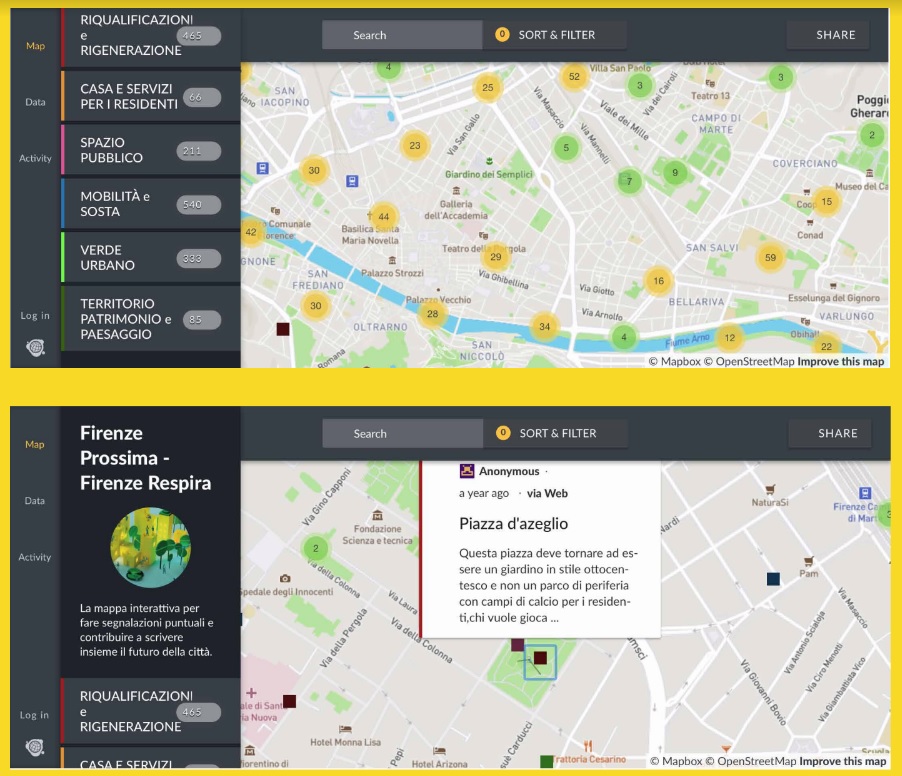Italy
Comune di Firenze
2020 - 2023
 16th.
Special Mention
16th.
Special Mention
FirenzeProssima aims at planning the development of the city of the future, its strategic vision, and the more specific aspects, co-designing with the citizens/stakeholders the desired/expected transformations, also taking into account the challenges imposed by the pandemic and climate change, also explaining why some solutions are needed. An interaction to define solutions tailored to different targets, with particular attention to young and weak people, through the networks of neighbourhoods and districts, through a territorial mapping made by those involved being resident or users experiencing the city services and facilities.
To improve the quality of public decision making through the mechanisms of participatory democracy.
An interaction to define solutions tailored to different targets, with particular attention to young and weak people, through the networks of neighbourhoods and districts, through a territorial mapping made by those involved being resident or users experiencing the city services and facilities.
FirenzeProssima experience was realized together with "FirenzeRespira" (https://partecipa.toscana.it/web/firenze-respira ), the participatory process for the drafting of the Green Plan as part of the City Operational Plan dedicated to greenery as a space to be experienced, with a view also to inclusiveness involving local private/public actors.
Common stages: 5 in-person Point Lab held in each District, where citizens could interact with facilitators on both pathways. Over 12.000 participants (online and offline), about 800 proposals presented on the interactive map.
FirenzeProssima also capitalized the outcomes of the listening process "RinasceFirenze" (https://www.comune.fi.it/rinascefirenze) held in 2020 through online questionnaires (7845 contributions collected). A plan for post-pandemic city recovery that outlining priorities in the near future to build back better on: Polycentric city; New vocation for the historical centre; Living urban spaces; Green mobility; City economy development; Widespread culture; Children and families at the centre; Personal care: welfare, home, work; Boost the smart city.
Despite being a medium size city, Florence has about 550.000 daily city users and 14 millions tourists/year (before pandemic) as UNESCO site since 1982 and guaranteeing a balancing inhabitants/temporary users is a priority (people/associations can contribute to the Management Plan https://www.firenzepatrimoniomondiale.it/). Florence is not just a tourist destination, but also home of sectors of excellence such as manufacturing, fashion and design systems, high-tech, without forgetting the numerous universities and academies.
The city development is strongly constrained by boundaries to preserve its priceless cultural heritage, nevertheless, it is fully engaged in sustainable, innovative and inclusive urban transformations. Due to its human-centric approach, Florence adopted an interdisciplinary and integrated framework convinced that only enhancing synergies, empowering stakeholders, and involving citizens, the city can handle the challenges and improve liveability.
Committed to being a climate neutral city means facing climate change (amplified by the huge number of temporary city users) with a holistic vision combining cross-sectoral competences for the enhancement of social and biocultural assets. The main goals are a well-being city, a more inclusive leaving no one behind, and promoting opportunities for all; a city more attentive to the ecosystem where public (green) spaces are meant by people for people equipped for the largest use/fruition, not merely kept but enhanced for socialization and integration. Florence also provides quality digital services to make life easier, accessible to all within the general framework to save CO2 emissions and reduce pollution, thus improving liveability.
The Pandemic taught us that public (green) spaces are essential for health and well-being both in terms of community and proximity and urban planning. Aiming at rethinking our city, we are promoting the citizens' active participation in co-designing, improving their sense of belonging and care of the territory (see "RinasceFirenze", a document open to everyone's contribution for the recovery strategy https://www.comune.fi.it/rinascefirenze).

FirenzeProssima – Participate to the future is the 2021/2022 participatory process supporting the co-design of the main urban planning tools of the City of Florence:
- Structural Plan (PS), a long-term Plan (15/20 years) to draw the vision for territorial development and protection;
- City Operational Plan (POC), a medium-term Plan (5 years) to define how to implement the PS in terms of urban transformation: buildings, infrastructures and services. The POC also includes the Green Plan, a strategic tool for the design and enhancement of green areas, both public and private, as an asset for the community well-being.
FirenzeProssima aims at promoting citizens' participation involving different targets (with a special focus to young people) in designing the "city of tomorrow", for the benefit of the whole local community as well as enabling quality improvement of public decision making.
Based on the past experiences such as the "Marathons of Listening", FirenzeProssima capitalized on the outcomes of "RinasceFirenze", the 2020 citizens' engagement process collecting 7845 online questionnaires to define the post-pandemic city recovery plan. It was realized also in coordination with "FirenzeRespira", the participatory process for the drafting of the Green Plan (as part of the City Operational Plan) and consists of 3 phases:
(i) Design stage to prepare actions, taking into account the institutional and socio-economic context (mapping of actors/stakeholders, technical documents and guide for participants)
(ii) Open dialogue with citizens/stakeholders through:
- 3 Focus Groups: 30 economic actors (trade unions, entrepreneurs, professionals, associations);
- 6 Online meetings with citizens (1 kick-off plus 5 District's meetings): 300 participants;
- Itinerant Labs in 10 squares equipped as workstations: 273 participants;
- 5 Public meetings in presence around thematic issues supported by facilitators: 235 participants;
- interactive online/offline map as open device for participation: 1700 proposals collected
- Urban Innovation Lab: 68 students from 5 universities and design schools, 18 project ideas collected.
(iii) Outcomes showcase through:
- an interactive online exhibition;
- a public exchange event with 200 participants;
- reports available on the FirenzeProssima website and spread through social networks.

The recommendations emerged were divided into 2 classes: long-term (15/20 years, for Structural Plan) and short-term inputs (5 years, for City Operational Plan) and subsequently gathered into five thematic areas ("Florence works"; "Florence moves"; "Florence dwells"; "Florence lives"; "Florence regenerates").
These inputs allow the Municipality to translate the needs and suggestions expressed by citizens/stakeholders into operational indications for planning tools.
This shared building up process has strengthened the citizens' sense of belonging to the community as they felt protagonists in designing the vision of the "city of tomorrow" with the recognition of their ideas and proposals into the draft plans.
Furthermore, citizens have become familiar with urban planning tools and the related technical and procedural flows, developing a greater awareness of the policy decision making process.
The Plans are already available online and after the ongoing final consultation stage for additional comments, a Municipality interdepartmental group will update the POC and PS for the approval by the City Council.

More information:
It's an articulated process, well coordinated with other plans and processes. The project has an important external evaluation contribution. Mechanisms for the inclusion of people's ideas in the plans are of cherry picking type.
An experience focused on a specific topic, very well designed and implemented.